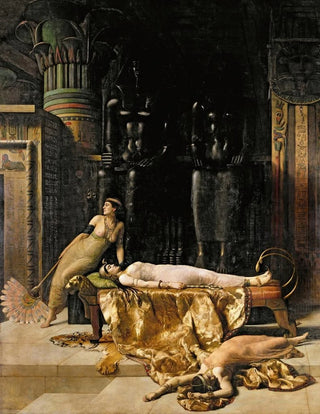Art print | The Death of Cleopatra - John Collier


View from behind

Frame (optional)
In the rich and complex panorama of art history, certain works stand out for their ability to capture deep emotions and poignant stories. "The Death of Cleopatra" by John Collier is undoubtedly one of these memorable creations. This painting, which evokes the tragic end of the famous Egyptian queen, transcends the simple artistic framework to become a true exploration of themes of beauty, death, and power. Through this artwork, Collier immerses us in a moment of dramatic tension, where every detail contributes to the atmosphere of inescapability surrounding Cleopatra's fate. In this art print, the artist manages to evoke a palpable melancholy, inviting the viewer to reflect on the fragility of life and the consequences of human choices.
Style and uniqueness of the work
John Collier's style in "The Death of Cleopatra" is characterized by an exceptional mastery of color and light. The rich and deep hues, combined with carefully studied lighting, create an ambiance that is both solemn and mysterious. The artist uses the contrast between shadows and highlights to emphasize the features of Cleopatra's face, whose expression is both resigned and imbued with dignity. Every element of the composition, from the sumptuous drapes to the surrounding objects, is carefully orchestrated to enhance emotion and storytelling. Collier thus manages to bring a historical moment to life, while leaving room for the viewer's imagination, who can wonder about the thoughts and feelings of this iconic figure. The richness of details and the finesse of textures testify to remarkable craftsmanship, making this work a true masterpiece of Victorian art.
The artist and his influence
John Collier, a British painter of the 19th century, is often associated with the Pre-Raphaelite movement, although he developed a distinctive style characterized by his narrative and dramatic approach. His interest in historical and literary themes leads him to explore various subjects, but it is in the depiction of emblematic female figures that he truly excels. Cleopatra, as

Matte finish

View from behind

Frame (optional)
In the rich and complex panorama of art history, certain works stand out for their ability to capture deep emotions and poignant stories. "The Death of Cleopatra" by John Collier is undoubtedly one of these memorable creations. This painting, which evokes the tragic end of the famous Egyptian queen, transcends the simple artistic framework to become a true exploration of themes of beauty, death, and power. Through this artwork, Collier immerses us in a moment of dramatic tension, where every detail contributes to the atmosphere of inescapability surrounding Cleopatra's fate. In this art print, the artist manages to evoke a palpable melancholy, inviting the viewer to reflect on the fragility of life and the consequences of human choices.
Style and uniqueness of the work
John Collier's style in "The Death of Cleopatra" is characterized by an exceptional mastery of color and light. The rich and deep hues, combined with carefully studied lighting, create an ambiance that is both solemn and mysterious. The artist uses the contrast between shadows and highlights to emphasize the features of Cleopatra's face, whose expression is both resigned and imbued with dignity. Every element of the composition, from the sumptuous drapes to the surrounding objects, is carefully orchestrated to enhance emotion and storytelling. Collier thus manages to bring a historical moment to life, while leaving room for the viewer's imagination, who can wonder about the thoughts and feelings of this iconic figure. The richness of details and the finesse of textures testify to remarkable craftsmanship, making this work a true masterpiece of Victorian art.
The artist and his influence
John Collier, a British painter of the 19th century, is often associated with the Pre-Raphaelite movement, although he developed a distinctive style characterized by his narrative and dramatic approach. His interest in historical and literary themes leads him to explore various subjects, but it is in the depiction of emblematic female figures that he truly excels. Cleopatra, as






